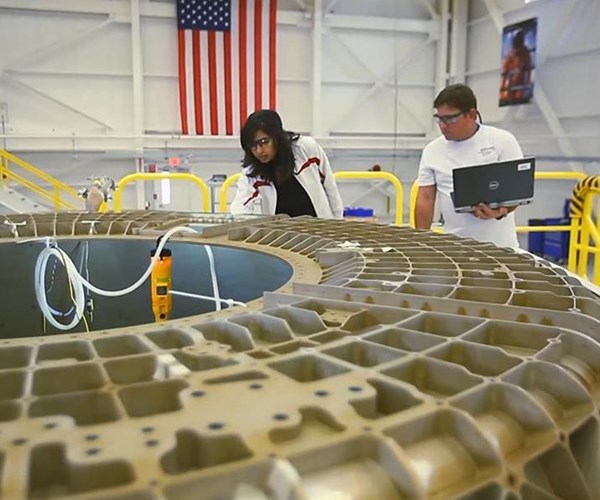VIDEO: Indiana's Imagineering Finishing Technologies Works on Boeing's $4.2B Spacecraft
Boeing’s Crew Space Transportation, CST-100, is part of NASA’s Commercial Crew Program, which aims to resume U.S.-based flights to space.

Boeing employees work on the CST
Indiana-based Imagineering Finishing Technologies (IFT) is working on Boeing’s Crew Space Transportation, CST-100, part of NASA’s Commercial Crew Program, which aims to resume U.S.-based flights to space.
According to an article by Inside Indiana Business, IFT is working on the “upper dome,” which they say is a portion of the capsule on a NASA space vehicle designed to hold astronauts—and eventually, commercial passengers—as they venture into space.
IFT takes the 9-ft. wide by 4-ft. high component and inspects it for any contaminants, then performs a tightly-controlled chemical etching process that removes a few 0.0001" from the surface.
They then inspect for any deformities in the metal before applying a protective coating that prevents corrosion of the base material.
Boeing received $4.2 billion from NASA to build and fly the U.S. next passenger spacecraft.
Boeing’s Crew Space Transportation (CST)-100 is being developed as part of NASA’s Commercial Crew Program, which aims to resume U.S.-based flights to space by 2017. The CST-100 will transport up to seven passengers or a mix of crew and cargo to the International Space Station (ISS) and other low-Earth orbit destinations.
“Boeing has been part of every American human space flight program, and we’re honored that NASA has chosen us to continue that legacy,” said John Elbon, Boeing vice president and general manager, Space Exploration. “The CST-100 offers NASA the most cost-effective, safe and innovative solution to U.S.-based access to low-Earth orbit.”
Under the Commercial Crew Transportation (CCtCap) phase of the program, Boeing will build three CST-100s at the company’s Commercial Crew Processing Facility at Kennedy Space Center in Florida. The spacecraft will undergo a pad-abort test in 2016 and an uncrewed flight in early 2017, leading up to the first crewed flight to the ISS in mid-2017.
Boeing recently completed the Critical Design Review (CDR) and Phase Two Spacecraft Safety Review of its Crew Space Transportation (CST)-100 spacecraft, becoming the only competitor for NASA’s Commercial Crew program to pass a CDR as well as complete all CCiCap milestones on time and on budget.
“The challenge of a CDR is to ensure all the pieces and sub-systems are working together,” said John Mulholland, Boeing Commercial Crew program manager. “Integration of these systems is key. Now we look forward to bringing the CST-100 to life.”
More information about the CST-100 can be found at Boeing.com/cst100.
Related Content
-
NASF/AESF Foundation Research Project #122: Electrochemical Approaches to Treatment of PFAS in Plating Wastewater - 10th Quarterly Report
The NASF-AESF Foundation Research Board selected a project addressing the problem of PFAS and related chemicals in plating wastewater streams. This report covers the 10th quarter of work (April-June 2023). Here, we examine the effect of surface fluorination of Ti4O7 anodes on PFAS degradation performance in terms of energy performance as well as formation of chlorate and perchlorate when chloride is present in the solution. The full paper on this work can be accessed and printed at short.pfonline.com/NASF24Feb2.
-
Ultrafiltration Membranes, Filter Elements for Improved Industrial Water Reuse
Ultrafiltration membranes help with water reuse in a variety of applications.
-
Explore Cleaning Chemistry, Metal Finishing Applications and Wastewater Treatment Solutions
Hubbard-Hall Celebrating 175 years of excellence, Hubbard-Hall presents chemistry and equipment.









.jpg;maxWidth=300;quality=90)





